|
Back Splice (3-strand) - Used
to finish the end of a rope to prevent unraveling and to make it nicer to
handle.
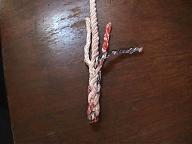 Back to the top |
Back up to Quick Navigation
California Taper - A means of tapering a splice to provide a smoother
transition from the rope's diameter to the splice's increased (roughly doubled)
diameter. This is done by continuing to tuck one of the strands one
additional time and another strand two additional times beyond the end of the
standard splice. The effect is to have the termination points of the three strands spread
out down the length of the line.
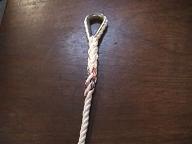
Back to the top |
Back up to Quick Navigation
Cut Splice - Used for joining two 3-strand ropes together with the joint
offset such that a loop or eye is formed in the line. This can be useful
for creating an attachment point for other lines, or for the cut splice's eye to
pass over a spar.
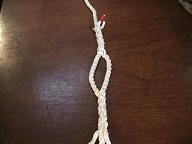 Back to the top |
Back up to Quick Navigation
Earring Splice or Earring Cringle - A means of splicing in a strong eye
or cringle into a rope-bordered awning or sail. This allows a line to be
attached the object without having to punch a hole into the fabric for a grommet
and sacrifice its strength, grommets always being a weak point. The
earring splice is done via the same method as a Cut Splice. Back to the top |
Back up to Quick Navigation
Eye Splice (double-braid) -
Used for making a permanent loop or eye in double-braid rope (commonly used as
halyards and sheets on sailboats). Back to the top |
Back up to Quick Navigation
Eye Splice (3-strand) - Used
for making a permanent loop or eye.
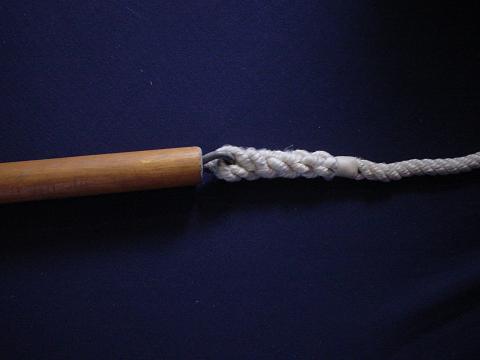
Back to the top |
Back up to Quick Navigation
Eye Splice
and Toggle - A handy method of creating a loop that can be quickly connected
and disconnected, while at the same time being strong and 'salty' in appearance.
The eye splice and toggle shown below is used at the stern of my boat to hang a
coil of anchor line for my spare stern anchor. The eye splice and toggle
is tied to a railing using a constrictor hitch (a clove hitch would do as well)
such that the wooden toggle is close to the knot, giving the eye portion some
additional length. The eye portion is passed through the coil of rope and
then connected to the toggle, hanging the coil handily from the railing.
The eye portion is a standard eye splice with a crown/wall knot at the throat,
finished with a whipping. The toggle portion is also done with a very
tight eye splice (so that the rope seats securely in a groove in the wooden
toggle), and is whipped at the throat and at the end for additional security.
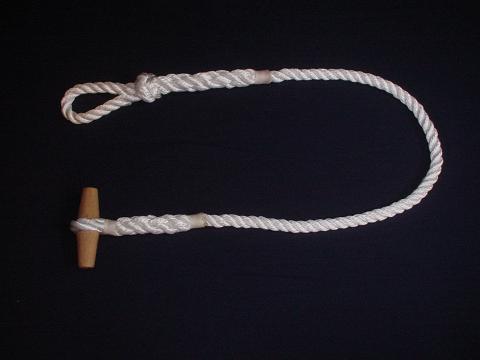
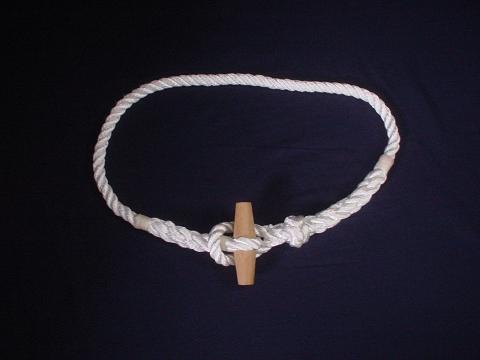
Back to the top |
Back up to Quick Navigation
Long Splice - Used for
joining two 3-strand ropes together with the minimum possible increase in
diameter. The drawback of using this splice is that it is only 2/3 as
strong as the original rope. If maximum strength is required, a Short
Splice may be needed. Shown below is a Long Splice on the left with an
example of a Short Splice on the right, both using 3/8" nylon rope. You
can see there is quite a difference in diameter!
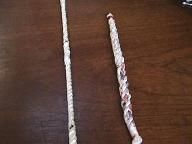
Back to the top |
Back up to Quick Navigation
Ring or Shackle Splice - Used for attaching a rope to a ring or shackle.
This splice is started with a Crown knot, much the same way as in a Back Splice
but with the Crown Knot passing through the ring or eye of the shackle.
This provides a tight connection between the rope and the ring and helps reduce
chafe.
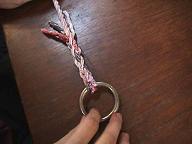
Back to the top
Short Splice - Used for
joining two 3-strand ropes together. This is a very strong method of
splicing, but causes the diameter of the rope to nearly double at the splice
point. If the rope must pass through a tight-fitting block or pulley, a
Long Splice may be required. The short splice shown below is tapered - it
has extra tucks with half the strand material removed in order to make a smooth
transition from the line's single diameter, to the 1.5x diameter of the taper,
to the 2.0x diameter of the short splice.
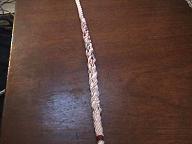
Back to the top |
Back up to Quick Navigation
Rope to Wire Splice - Used for joining rope to wire-rope. This
wire-rope splice is commonly used in sailboat halyards (my boat has at least
four
of them).
Back to the top |
Back up to Quick Navigation
Wall and Crown Knots - A decorative touch that can easily be applied to
your splices. On the left is a Double Wall and Crown applied to the throat
(near the thimble) of an eye splice after one full tuck has been applied.
On the right is a Single Wall and Crown applied to the end of a back splice,
after all the tucks are completed and before the splice is finished with a
whipping.
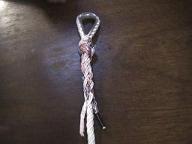
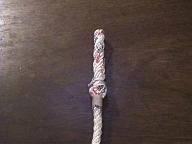
Back to the top |
Back up to Quick Navigation
Thanks for taking a look at our rope splices page. If you have any questions or
comments, would like to see any additional instructions on splicing
rope, or are interested in our new
3-strand rope splicing DVD,
please contact us! |










